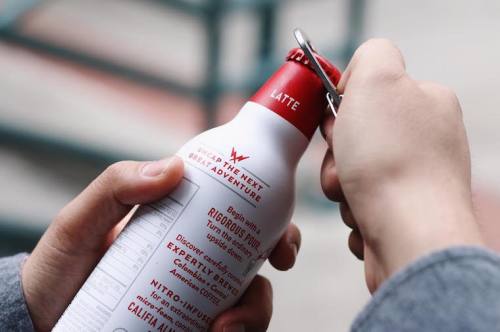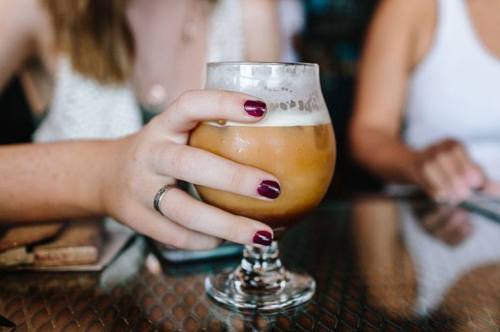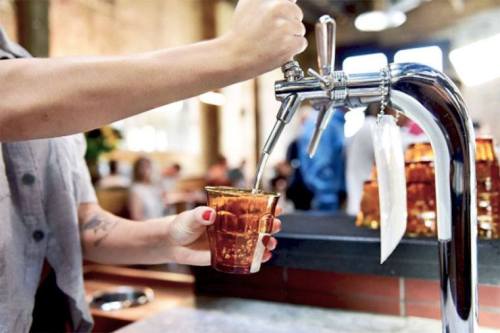Our editors independently select these products. Making a purchase through our links may earn Well+Good a commission
Hang around any buzzy fitness studio and you’re bound to see women clutching more than just S’well water bottles. Despite a rainbow of healthy drink options available right now, the prevailing a.m. beverage color is still black.
And as we officially enter iced coffee season, it’s not just any kind of brew that’s trending among the wellness set. Nitro coffee, specifically, has become as ubiquitous as those star-spangled Ultracor leggings, in part because it’s arguably healthier than your average cup of joe.
Whether you get your fix from a can (courtesy of La Colombe and Califia Farms) or on tap (Juice Press, Starbucks, and even fitness studios like New York Pilates will soon be offering it up), it’s safe to say that there’s no buzzier way to get your buzz.
Why all the hype—and what, exactly, makes nitro a healthier coffee option? Here’s what you need to know.

Sweetness without the sugar
When nitrogen—a colorless, orderless gas—is added to coffee, you get nitro brew. Although it may sound like a strange combination, it’s not a totally new phenomenon. “[Drink makers] have been putting gas in beverages for a long time,” says La Colombe co-founder Todd Carmichael, rattling off sparkling water, soda, and beer as examples.
So why the switch from reliable carbon dioxide to nitrogen, which doesn’t mix with liquid as easily? “It makes the texture more foamy,” says Brian Lovejoy, general manager of coffee for Califia Farms. That explains why a glass of nitro coffee looks similar to a frothy beer, and has a comparable thickness.
“The nitro foam gives a perception of sweetness without anything being added.”
Rather than adding the signature fizz of CO2, nitrogen’s pop comes in the taste department. “The nitro foam gives a perception of sweetness without anything being added,” Lovejoy explains. “It tricks the tongue by hitting it at different places and bringing out more flavor.”
And that’s where its health cred comes in: Unlike other types of coffee, which can sometimes skew bitter, nitro doesn’t require sugar to taste amazing. “You can achieve the taste your tongue likes without adding any sugar to it at all,” says Carmichael.
Another upside to nitro: Cold brew in general is less acidic than hot coffee because the beans are steeped for hours (or even days), whereas the drip variety is ground up and served more quickly. This results in a richer, less sour taste—and one that’s not as harsh on the gut.

The rise of to-go nitro
Traditionally, nitro coffee was only available from a tap, since it’s tricky to get the same nice, frothy head from anything bottled. But finally—finally!—it’s being figured out.
Since keeping nitrogen from escaping the liquid is pretty tricky, you can imagine how hard it is to try and package it. La Colombe literally brought in a scientist to help create the can for its draft latte. “He said what we achieved was harder than rocket science,” Carmichael says. La Colombe also opted to use nitrous oxide instead of straight-up nitrogen—it stays in liquid longer, keeping the coffee foamy even after the seal is broken. “You want those bubbles to last the entire experience, like a glass of champagne,” he says.
“He said what we achieved was harder than rocket science.”
Califia Farms cans its nitro with an almond-macadamia milk blend, making it extra creamy. “Nitrogen is more soluble in healthy fats, so when you pour it, you’ll notice a nice cascade and rich head of foam on top,” Lovejoy says. (Plus, every health nut—no pun intended—knows that healthy fats are good for you.)
And they’re not the only brands that have mastered the art of on-the-go nitro. Lucky Jack, Rabbit Coffee, Rise Brewing Co. and Stumptown all sell pre-bottled brews that mimic the flavor and texture of nitro from a tap.

But first, world domination
Because nitro coffee offers up a healthier caffeine boost, some boutique fitness studios are starting to serve it up as an added, er, perk. (Caffeine’s thought to help fuel workouts, and it’s also a great reason for classgoers to stick around and get to know each other.)
Vibetality Yoga in Arizona introduced nitro on tap last year, and New York Pilates is working to get its own draft up and running at its Bowery location this summer. Wellness-centric cafes and restaurants have started tapping the trend as well. One such destination is Coco & Cru, also located in downtown New York City. “We take our coffee program very seriously and felt that we would be letting customers down if we didn’t have this on our menu,” says owner Adam Elzer.
Because nitro coffee offers up a healthier caffeine boost, some boutique fitness studios are starting to serve it up as an added, er, perk.
Given the quick ascent of the nitro craze, Carmichael can’t help but think back to the first time he put coffee over ice. “In 1994, someone came in and asked me to make an iced latte. I thought it was the strangest thing I ever heard—like serving up a nice, hot flute of champagne,” he recalls. “Now, it’s no longer an anomaly. Not only is it a legitimate way to drink coffee, it’s the go-to way.”
Consider your French press warned—the future might be kegs and taps in kitchens.
Speaking of coffee, it’s time to settle the debate of whether it’s good for you or not. No nitro nearby? Here’s how to make your coffee healthier, Bulletproof-style.
Sign Up for Our Daily Newsletter
Get all the latest in wellness, trends, food, fitness, beauty, and more delivered right to your inbox.
Got it, you've been added to our email list.











